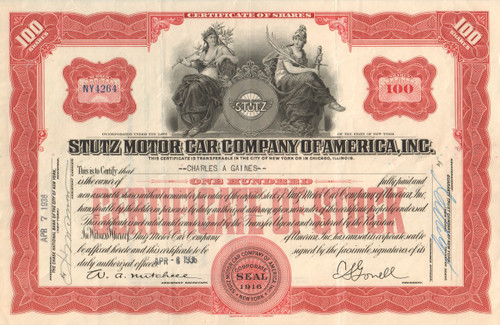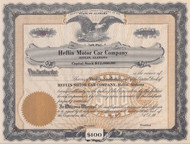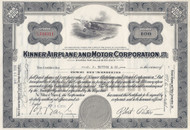Categories
Categories
- Home
- Automotive
- Automakers
- Stutz Motor Car Company of America Inc. 1936 (Indiana)
Stutz Motor Car Company of America Inc. 1936 (Indiana)
Product Description
Stutz Motor Car Company of America Inc. stock certificate 1936 (Indiana)
Very desirable automotive collectible - a premium piece. Very nice vignette of the Stutz logo flanked by two seated classical female figures. Issued and not cancelled. Dated 1936 at the end of the company's life.
The Stutz Motor Company was a producer of luxury cars based in Indianapolis IN. Production began in 1911 and continued until 1935. The brand reappeared in 1968 under the aegis of Stutz Motor Car of America, Inc., and with a newly defined modern retro-look. Although the company is still active today, actual sales of factory produced vehicles ceased in 1995. Throughout its history, Stutz was known as a producer of fast cars (America's first sports car) and luxury cars for the rich and famous.
The company was founded as the Ideal Motor Car Company in Indianapolis, Indiana in 1911. Ideal entered a car in the Indianapolis 500 that year and placed 11th, earning it the slogan, "the car that made good in a day". The next year, the founder, Harry C. Stutz, renamed the company Stutz Motor Company and began selling high-performance roadsters like the famous Stutz Bearcat. The Bearcat featured a brawny 4-cylinder T-head engine with four valves per cylinder, one of the earliest multi-valve engines. Stutz has also been credited with the development of "the under-slung chassis", an invention that greatly enhanced the safety and cornering of motor vehicles and one that is still in use today. Stutz "White Squadron" race team won the 1913 and 1915 Championships.
Stutz was forced to raise money to fund his automobile production, eventually selling the company in 1919 after a falling out with the company's major stockholders, Allan A. Ryan, who then went bankrupt. In 1922, three Stutz investors, one of whom was Charles M. Schwab, gained control of the company. The new owners brought in Frederick Ewan Moskowics, formerly of Daimler-Motoren-Gesellschaft, Marmon, and Franklin, in 1923. Moskowics quickly refocused the company as a developer of safety cars, a recurring theme in the auto industry.
In the case of Stutz, the car featured safety glass, a low center of gravity for better handling, and a hill-holding transmission called "Noback". One notable advance was the 1931 DOHC 32-valve in-line 8 called the "DV32" (DV for 'dual valve'). This was during the so-called "cylinders race" of the early 1930s, when makers of some expensive cars were rushing to produce multi-cylinder engines. Stutz did not go to the V12 and V16 engines, but instead stayed true to its performance heritage with the dual overhead cam 8 design as used on the sporting cars of the era such as Bugatti, Alfa, Duesenberg and Miller. Brochures boasted 100 mph+.
In 1927, a Stutz set a world record for speed, averaging 68 mph for 24 hours. The following year, a 4.9 liter Stutz in the hands of by Robert Bloch and Edouard Brisson finished second at the 24 Hours of Le Mans (losing to the 4.5 liter Bentley of Rubin and Barnato, despite losing top gear 90 minutes from the flag), the best result for an American car until 1966. That same year, development engineer and racing driver Frank Lockhart used a pair of supercharged 91ci DOHC engines in his Stutz Black Hawk Special streamliner LSR car, while Stutz set another speed record at Daytona, reaching 106.53 mph in the hands of Gil Anderson making it the fastest production car in America.
In 1927, Stutz won the AAA Championship winning every race and every Stutz entered finished. In 1929, three Stutzes, with bodies designed by Gordon Buehrig, built by Weymann's U.S. subsidiary, and powered by a 155hp 322ci supercharged straight 8 ran at Le Mans, piloted by Edouard Brisson, George Eyston (of land speed racing fame), and co-drivers Philippe de Rothschild and Guy Bouriat; de Rothschild and Bouriat placed fifth after the other two cars fell out with split fuel tanks. Production ended in 1935 after 35,000 cars had been manufactured. The company fell victim to the Depression.
 Loading... Please wait...
Loading... Please wait... 








